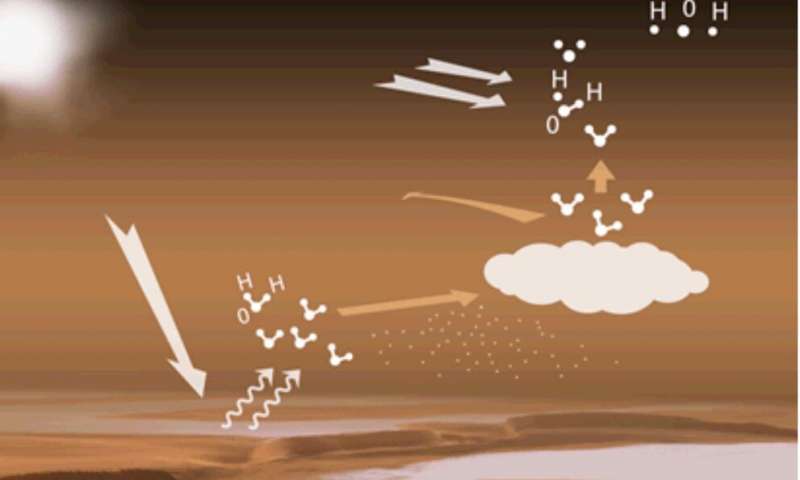Although it is now barren and inhospitable, as early as two billion years ago, Mars’ surface was covered in water in the form of rivers, large lakes, and even a huge ocean. Scientists are coming closer to piecing together the events that eventually caused the Red Planet to lose most of its water. But, for now, a new study suggests that water loss on Mars may be a lot worse than we thought.

All that remains of the planet’s once plentiful water is now trapped as ice in the Red Planet’s polar ice caps. By one estimate, these regions contain less than a tenth of all the water that flowed on the Martian surface billions of years ago.
The rest escaped into space after ultraviolet radiation from the sun — unhindered by Mars’ extremely thin atmosphere (roughly 100 times less than Earth’s) and its absent magnetic field — broke apart water molecules into oxygen and hydrogen. The gaseous hydrogen, which is not nearly as bound to gravity as on Earth (Mars has a 60% weaker gravity), freely travels right off into space.
According to new research that analyzed data from the Trace Gas Orbiter, an orbiting spacecraft operated by the European-Russian ExoMars program, this process may occur at a faster rate than previously thought.
When the powerful UV rays hit the frozen Martian poles, water vapor forms and travels towards higher and colder altitudes transported by wind. Normally, dust particles in the atmosphere and the cold temperature should condense the water vapor to form clouds like on Earth. However, on Mars, this condensation is, most of the time, hindered. This causes the upper atmosphere to become supersaturated in water vapor, accelerating the escape of hydrogen molecules into space.
“Because supersaturation is observed concomitantly with dust or ice particles, we conclude that condensation does not efficiently prevent water vapor from becoming supersaturated, even when seeds for condensation exist. We speculate that this may be due to rapid drops in temperature and/or rises in water concentration, which occur faster than condensation can keep up with,” the authors wrote in their study.
Researchers led by Franck Montmessin, a planetary scientist at the University of Paris-Saclay and the Centre National de la Recherche Scientifique (CNRS) in France, found that water vapor is accumulating in unexpected proportions in the Red Planet‘s upper atmosphere, at an altitude of about 80 kilometers.
Measurements show that some pockets of the upper atmosphere contain 10 to 100 times more water vapor than the temperatures should theoretically allow. This relationship is mitigated by seasonal changes. For instance, the atmosphere became the most saturated with water vapor during the warmest and stormiest part of the Martian year.
As spacecraft currently orbiting Mars gather more data, we may come to learn more about how water vapor and the planet’s atmosphere. Ultimately, we might also learn what eventually led to Mars losing all its liquid water from the surface.
The findings were reported in the journal Science.






